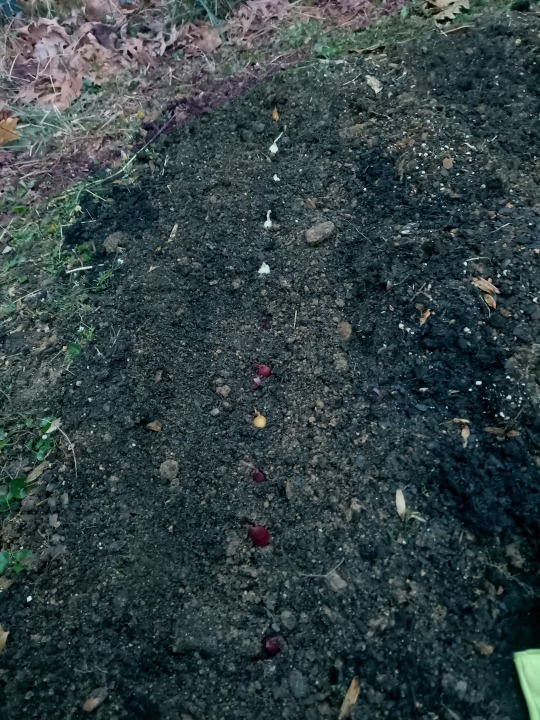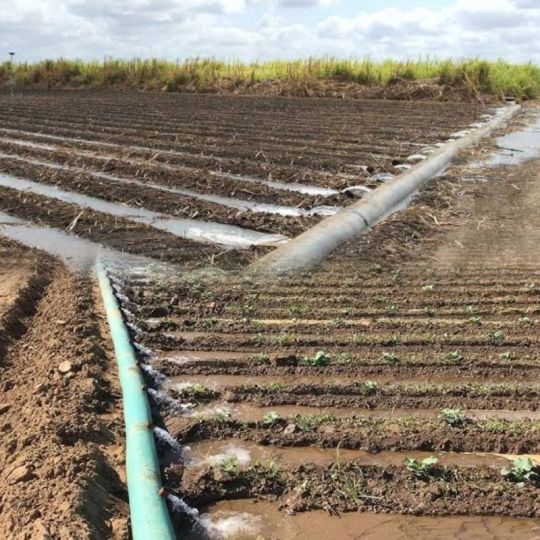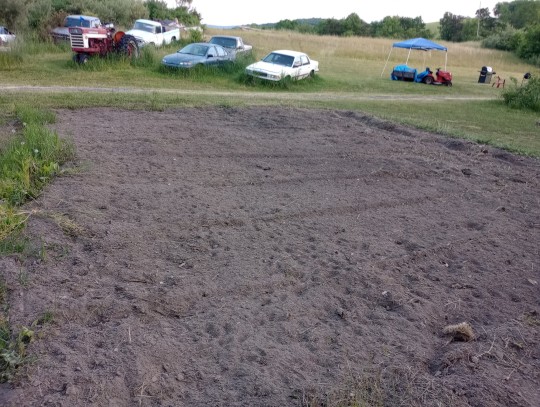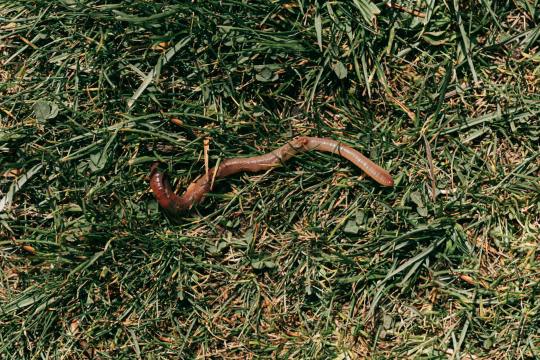#soil preparation
Explore tagged Tumblr posts
Text
Today!! Progress in motion, it feels good. Almost sowed the cabbage but there's roots there I gotta figure out before planting.
Germinated:
- 7 cauliflower seeds !!! They should pop out the green tomorrow
- a few nasturtium seeds, hallelujah!!!
Preparation:
- Hoed and raked the beds again, then Added soil mix to strawberries, Brussel sprouts, and root vegetables beds.
- Added the rest of the mix to two raised beds. Found a lot of potatoes in those beds, soil in good condition.
Sowed:
- 3 rows of onions in root vegetables bed


- 2 half rows of beets in root vegetables bed, 3 seeds together at a time because I watched a video today showing beets like to be very close to each other and push each other out of the ground?
- whole bed of Brussel sprouts, pretty much the whole packet ~30 seeds in
- an area of beets in shed side raised bed 3
- 1 row of sprinkled chives seeds alongside the beets and the wall of the bed. That bed is complete, I believe.
Watered everything too far for the hose with a spray bottle, painstakingly.

Lined the Brussel sprouts with rocks I found in honor of my wife's work and style in landscaping. 💘
#Gardening#Plantblr#Garden#home garden#Sowing#Soil preparation#Onions#Beets#brussel sprouts#Chives#gardenblr#garden journal#Germinated
13 notes
·
View notes
Text
Soil pH
What is the Meaning of pH? The term pH refers to the level of acidity or alkalinity of a substance. It’s based on a scale that ranges from 0 to 14, where a pH of 7 is considered neutral. Values below 7 signify acidity, while values above 7 indicate alkalinity. The pH scale is logarithmic, meaning each whole number change represents a tenfold difference in acidity or alkalinity. In simpler terms, a soil pH of 5 is ten times more acidic than a pH of 6.
Healthy soil pH is the foundation of a thriving garden. Find the balance, and your plants will flourish.
Understanding pH is important in soil science because it influences many soil properties, including nutrient availability, microbial activity, and plant growth. A proper balance of pH levels helps plants access nutrients more efficiently, making it an essential factor in successful gardening and farming.
What is the Best pH for Soil? The ideal pH range for most plants is between 6.0 and 7.0, which is slightly acidic to neutral. Within this range, most nutrients are readily available to plants. However, some plants have specific pH preferences. For instance, blueberries, azaleas, and rhododendrons thrive in more acidic soils with a pH between 4.5 and 5.5, while some ornamental plants and vegetables can tolerate slightly alkaline soils up to a pH of 7.5 or even 8.0.
How to Check pH in Soil? There are several ways to measure soil pH, ranging from simple DIY methods to professional testing:
pH Test Strips: You can purchase these at most garden centers. Simply mix a soil sample with distilled water, dip the test strip, and compare the color change to a pH chart.
Soil pH Meters: These electronic devices are quick and easy to use. Insert the probe into the soil, and the meter will display the pH reading.
Professional Soil Testing Kits: These kits usually come with detailed instructions and provide more accurate results than DIY methods. Some local agricultural extension offices and labs also offer soil testing services for a fee, which can give you a complete analysis of soil pH and nutrient levels.
What pH is Rich Soil? Rich soil typically has a balanced pH range between 6.0 and 7.5. At this level, soil can retain essential nutrients like nitrogen, phosphorus, and potassium, which are crucial for plant health and growth. Rich soil with an optimal pH level supports a diverse range of plants, from vegetables to flowering perennials, as it creates a favorable environment for beneficial bacteria and earthworms that break down organic matter and enrich the soil structure.
What is High pH in Soil? When soil has a pH above 7.5, it’s considered alkaline. High pH soils can pose challenges, as they may limit the availability of essential nutrients like iron, manganese, and phosphorus. Alkaline soils often appear in areas with low rainfall or where the bedrock contains limestone or other alkaline minerals. Plants in high pH soils can sometimes show signs of nutrient deficiencies, such as yellowing leaves (chlorosis) due to iron deficiency. While some plants, like lavender and certain succulents, can tolerate or even prefer alkaline soils, most garden plants prefer slightly acidic to neutral conditions.
What pH Level is Healthy for Soil? A healthy soil pH typically falls between 6.0 and 7.5, though this can vary depending on the type of plants you’re growing. Maintaining a balanced pH level ensures that your plants can efficiently absorb nutrients, promoting healthy growth and resistance to diseases. Soil pH can fluctuate over time due to factors like rainfall, fertilizer use, and plant root activity. Testing your soil pH regularly can help you stay on top of any changes and adjust your soil management practices accordingly.
You can use soil amendments to adjust the pH level of the soil. For example, lime can raise pH for overly acidic soils, while sulfur can lower pH in alkaline soils. However, changing soil pH is a gradual process, and it’s best to make adjustments in small increments and monitor the results.
Conclusion Soil pH is a critical factor for plant health, as it affects nutrient availability, soil structure, and microbial activity. Aiming for a pH range between 6.0 and 7.0 can support the growth of a wide variety of plants and contribute to a thriving garden or farm. Regular soil testing can help you monitor pH levels and make informed decisions to maintain a healthy balance. By understanding and managing your soil's pH, you can create an environment where your plants can truly flourish.
4 notes
·
View notes
Text
How to grow vegetables in 6 simple steps?

Don't know where to start with your own vegetable garden? Check out our new infographic on How to grow vegetables in 6 simple steps! From selecting the right seeds to harvesting your bounty, our easy-to-follow guide will have you growing your own fresh produce in no time.
Visit www.yardener.com for more gardening resources.
Want more gardening resources? Check here
#Vegetable gardening#Gardening tips#Growing vegetables#Step-by-step gardening#Home gardening#Vegetable cultivation#Gardening for beginners#Organic gardening#Planting vegetables#Vegetable garden care#Gardening techniques#Growing your own food#Vegetable gardening guide#Sustainable gardening#Garden planning#Soil preparation#Free Gardening Information#Pest control in gardens#Yardener#Garden maintenance
11 notes
·
View notes
Text
Furrow irrigation, a time-tested agricultural practice
Furrow irrigation is an ancient and well-trusted way of watering crops that has been practiced for a very long time. This method involves creating small channels or furrows between the rows of crops to efficiently deliver water to the plants. It has proven to be especially effective for various crops like corn, soybeans, cotton, and vegetables. The basic idea is to make these channels alongside…

View On WordPress
#Agricultural practice#Ancient farming#Crop growth#Crop rows#Crop watering#Evaporation#farming techniques#Field management#Furrow irrigation#Gravity flow#Irrigation methods#Row crops#Runoff#Soil infiltration#Soil preparation#Sustainability#Traditional agriculture#Water conservation#Water distribution#Water efficiency
2 notes
·
View notes
Text




The last two years I tried doing the no till method with the KochLand Homestead Family Garden. I feel it went really well but my production has been down compared to 2020's "best ever" garden. Our Troy-Built Push behind rototiller is in need of work and honestly it sucks to use 😂. So yesterday my cousin brought his fancy utility tractor up and did what would have taken me hours to do by gand in ten minutes. Now I have a fresh canvas to work with, my yearly new row added in, and a small section left as is to continue the no till experience. Hopefully I will get my potatoes, sweet corn, sunflowers, and hot peppers in this week and I'll be off to a good start!
#garden#homesteading#pennsylvania#my work#farm#central pennsylvania#country living#farmlife#hustle#homestead#Rototiller#no till#soil preparation#soilhealth#soil quality#soil#organic farming#organic gardening
3 notes
·
View notes
Text
Why Choose Us For Soil Preparation Lalor
Preparing your soil is the foundation of every successful garden or landscape project. Whether you’re planting grass, flowers, or vegetables, having the right soil conditions matters. Our team provides expert Soil Preparation Lalor services to make sure your soil is ready to perform at its best. Let’s walk through the key steps that make our service stand out. Why choose us for site…
0 notes
Text

Flower gardening is a rewarding and therapeutic hobby that allows individuals to cultivate beautiful, vibrant spaces that provide aesthetic appeal, attract pollinators, and even improve mental well-being. Whether you have a sprawling backyard or a small balcony, flower gardening offers endless possibilities for creativity and personal expression.https://glimpsesofgarden.blogspot.com/
#This article explores the fundamentals of flower gardening#including selecting the right flowers#soil preparation#maintenance#and the benefits of growing flowers.
0 notes
Text
6 Expert Tips to Get Your Garden Soil Ready for a Thriving Spring

Embrace the joy of gardening this spring by mastering the art of soil preparation. Our article, "6 Essential Tips for Preparing Your Garden Soil for Spring", is chock-full of practical advice, ensuring your plants thrive in the upcoming growing season. Get to work with these soil preparation tips, which can not only guarantee a blossoming and lush garden but also provide you with a satisfying gardening experience. With wrong soil preparation, even the best gardening efforts will be in vain. Every garden is unique, thus understanding your soil and its needs is crucial. We're confident that the wealth of knowledge in this article provides exactly what you need to cultivate a garden that's the envy of the neighborhood. So, grab your gardening gloves and let's dig in! ```html
6 Essential Tips For Preparing Your Garden Soil For Spring
Spring is coming, and if you want a thriving garden, it all starts with the soil. Trust me, I’ve learned the hard way—neglect the dirt, and plants struggle. Take the time now, and you'll reap the benefits all season long.
1. Start With a Soil Test (Yes, It’s Worth It!)
If you've never tested your soil, you're gardening blindfolded. A simple test reveals pH levels, nutrient deficiencies, and what amendments your soil needs. Don’t guess—know.
2. Clear Out the Old, But Be Gentle
Yank out dead plants, but don’t go overboard disturbing the soil. Microbes and earthworms have been working hard all winter—don’t undo their progress. Instead, gently remove debris and leave the good stuff behind.
3. Feed the Soil, Not Just the Plants
Before you plant anything, enrich the soil with organic compost or well-rotted manure. Think of it as a nutrient buffet for your garden. Healthy soil produces stronger, more resilient plants.
4. Loosen, But Don’t Over-Till
Loosening compacted soil allows roots to breathe, but aggressive tilling destroys essential microbial life. I learned this lesson after one overzealous season left my soil dry and lifeless. Instead, aerate gently with a digging fork or broadfork.
5. Mulch Now, Thank Yourself Later
A layer of mulch locks in moisture, prevents weeds, and regulates soil temperature. Bonus: It also improves soil structure over time. I always use shredded leaves or straw—it’s free, effective, and breaks down beautifully.
6. Water Wisely Before Planting
Dry soil repels water, while overly wet soil can suffocate roots. The goal? Moist, crumbly soil that holds together when squeezed but doesn’t become a soggy mess.
Great gardens don’t start with seeds—they start with soil. Give it attention now, and the rest of the season will be far easier.
Want to take your soil prep even further? Check out my full guide on perfecting garden soil. Your plants will thank you.
``` Learn more about gardening with Taim.io!
0 notes
Text
In February, A Gardener's Thoughts Lightly Turn to Thoughts of Spring
As I write this, it’s cold and rainy outside, but my thoughts, like those of all gardeners, have already turned to spring. For gardeners, February is the time for spring garden planning, particularly if you’re into organic spring vegetable gardening. Late winter and early spring bring cold winds and rapidly fluctuating temperatures, but this time of the year, when we’re on the cusp between…

View On WordPress
#carrots#cool weather crops#cool weather gardening#frost tolerant vegetables#lettuce#organic spring gardening#raised bed gardening#soil preparation
0 notes
Text
Rotavator: A Key Tool for Efficient Soil Preparation

A rotavator is an essential farming tool designed to prepare soil for planting by tilling, mixing, and aerating the ground. It features rotating blades that break up compacted soil, making it easier to plant seeds and improve crop growth. The rotavator helps save time and effort compared to manual tilling, ensuring a smoother, more consistent soil surface. Whether you're working on a small farm or large agricultural land, this versatile machine helps increase productivity and soil health. With adjustable settings, it can handle various soil types, making it a valuable tool for efficient farming.
0 notes
Text

Why SBJ Nirmal L Type 14x57 Rotary Hoe/Blade is the Ideal Choice for Farmers
When it comes to preparing soil and ensuring crops have the best start possible, farmers know that quality tools make all the difference. The right rotary Hoe/Blade can mean the difference between smooth soil preparation and days of unnecessary struggle. That’s where SBJ Nirmal L Type 14x57 Rotary Hoe/Blade comes in. With its efficient design and high-quality materials, this blade is made to withstand the challenges of modern farming. Let’s dig deeper into why this blade is so special and what sets it apart in the world of agricultural tools.
What is a Rotary Hoe/Blade, and Why is it Important?
A rotary Hoe/Blade is a critical part of a rotavator, a piece of farming equipment used to break up and aerate the soil. In simple terms, a rotary Hoe/Blade spins into the ground, digging up soil to prepare it for planting. This process helps improve soil structure, aerates it for plant roots, and controls weeds—all vital aspects for healthy crop growth.
The L-shaped design of the SBJ Nirmal 14x57 blade makes it especially effective at penetrating soil. Its unique shape allows the blade to dive deep into the ground with each pass, giving a more thorough till. Whether you’re dealing with compact, rocky, or sandy soil, this blade is built to handle it. Many farmers appreciate this blade because of its ability to handle different soil types without losing efficiency.
Made from Boron Steel: Built to Handle Tough Jobs
One standout feature of SBJ Nirmal L Type 14x57 Rotary Hoe/Blade is the boron steel material it’s crafted from. For those unfamiliar with boron steel, it’s a high-strength steel alloy that includes a small amount of boron. This might seem like a minor addition, but that tiny amount of boron gives the steel incredible strength, hardness, and durability. Farmers benefit from boron steel because it makes the blade tough enough to withstand harsh soil conditions.
Here’s a bit more on boron steel’s advantages:
High Hardness and Strength: Boron gives steel an extra level of hardness and wear resistance. Since farming equipment often takes a lot of punishment, this extra hardness is a huge plus, meaning less wear and fewer replacements.
Resistance to Abrasive Soils: In areas with rocky or gritty soil, blades can wear down fast. Boron steel holds up well against abrasive materials, allowing it to dig deeper and last longer than standard steel.
Great Flexibility: Even though it’s hard and strong, boron steel maintains a level of flexibility. This balance is crucial since overly rigid materials can break under heavy stress, but boron steel can bend without snapping.
With boron steel, SBJ Nirmal blade provides a mix of strength and endurance that most standard blades lack. Farmers who use it report longer life spans for their blades, reducing the need for frequent replacements.
Powder Coating: Protecting the Blade Against Rust and Wear
On top of using durable boron steel, SBJ Nirmal adds a powder coating to its L Type 14x57 Rotary Hoe/Blade. This is a special process where a powder made of resin, pigment, and other particles is applied to the blade’s surface, then heated to form a strong, protective layer. The result is a coating that protects the blade from rust, moisture, and other weather-related damage.
Powder coating is an important feature for a few reasons:
Rust Resistance: As any farmer knows, equipment that stays outdoors is prone to rust. The powder coating provides an extra layer of protection, keeping the blade rust-free and extending its lifespan.
Weatherproofing: From rainy seasons to dry spells, farm equipment faces a range of weather conditions. Powder coating prevents moisture from seeping into the metal, so the blade doesn’t corrode or degrade.
Easy Maintenance: Powder-coated blades are much easier to clean, requiring only a quick rinse to remove dirt or mud. This saves time for busy farmers who want reliable, low-maintenance equipment.
Key Benefits for Farmers Using SBJ Nirmal 14x57 Rotary Hoe/Blade
So, why do farmers trust this particular blade for their rotavators? Here are some of the top reasons this blade has become a popular choice:
Efficient Soil Penetration: The L-type shape is optimized for soil penetration. Its angled edges dig in smoothly, so the blade can handle dense soil without wearing down quickly. This shape also makes it easier to prepare seedbeds with fewer passes, which is a big time-saver.
Versatility Across Soil Types: One major benefit of SBJ Nirmal L Type 14x57 blade is its versatility. Farmers use it successfully on everything from clay-rich soil to sandy ground, as well as rocky areas. This versatility means farmers don’t need different blades for different fields.
Cost-Effective Over Time: Since it’s built to last, this blade is a good investment. The initial cost may be a bit higher than standard blades, but over time, farmers save on replacements and repairs. For those managing large areas or frequent tilling, this long-lasting blade proves especially economical.
Low Maintenance Requirements: With the combination of boron steel and powder coating, this blade is tough and easy to care for. It can handle wet, muddy fields without rusting or degrading, meaning it’s always ready for the next job.
SBJ Nirmal: A Brand Farmers Trust
SBJ Nirmal Products has earned a reputation as a reliable supplier of high-quality rotavator parts. The company’s commitment to quality is clear in every part they produce, especially in their L Type 14x57 Rotary Hoe/Blade. They’re known for their consistent focus on durability and performance, ensuring farmers have tools they can rely on year after year.
In the end, SBJ Nirmal L Type 14x57 Rotary Hoe/Blade is an ideal choice for farmers looking to optimize their soil preparation process. It combines strength, resilience, and smart design, all essential features for today’s agricultural needs. By investing in a blade built to last, farmers can spend more time focusing on their crops and less time worrying about tool maintenance.

#Rotary Hoe Blade#SBJ Nirmal Products#L Type 14x57 Blade#Boron Steel Blade#Powder Coated Blade#Durable Farming Tools#Soil Preparation#Rotavator Parts#Agricultural Equipment#Farming Efficiency#Rust Resistant Blade#High-Quality Rotary Blades#Long-Lasting Farming Tools#Efficient Soil Cultivation#Weed Control Blade
0 notes
Text
How To Grow Cannabis - The Complete Guide For Beginners
Cannabis farming, which used to be something of an exclusive hobby, has grown into a multi-billion-dollar industry, but the truth is this industry is no longer a preserve for the experts. Changing laws and growing interest in growing cannabis indoors have made more people give it a shot at home. Of course, the process can be quite intimidating for beginners with little or no knowledge about the…
#Cannabis Cultivation#cannabis growing tips#cannabis plants#Cannabis Seeds#complete guide#grow cannabis#harvesting cannabis#hydroponic growing#indoor grow#light cycle#outdoor grow#soil preparation#step by step
1 note
·
View note
Text
Growing Raspberries in Your Backyard: A Comprehensive Guide
Raspberries are not only delicious and juicy but also a great addition to any garden. While they require some care, with the right approach, you can enjoy a bountiful harvest. This article covers essential steps for growing raspberries, from soil preparation to pest control, and includes some handy tips for success. Continue reading Growing Raspberries in Your Backyard: A Comprehensive Guide
#growing raspberries#pest control for raspberries#raspberry care#raspberry mulching#raspberry planting#raspberry pruning#raspberry watering#soil preparation
0 notes
Text
Blog Message "Unlocking the Keys of Successful Horticulture: Tips and Tricks for a Thriving Garden
"
Horticulture is not simply a pastime; it's a restorative and rewarding activity that enables people to link with nature and witness the elegance of growth firsthand. Whether you're a seasoned gardener or a newbie wanting to grow your green thumb, there are necessary suggestions and tricks that can help you produce a thriving garden. From selecting the right plants for your climate to understanding the art of watering and feeding, this article will look into the secrets of successful gardening that will raise your outdoor space.In addition to
the practical elements of horticulture, this article will certainly additionally explore the psychological and psychological advantages of supporting a yard. Research studies have revealed that spending time in nature and having a tendency to plants can lower tension, boost state of mind, and rise total well-being. By submersing yourself in the serene and introspective practice of horticulture, you can create a peaceful oasis in your very own backyard that works as a shelter from the needs of everyday life. Join us on a trip to discover the delights of horticulture and unlock the potential of your outdoor space.
Read more here https://taterjunction.com
0 notes
Text

Understanding the importance of soil preparation is essential for a successful garden. Learn how proper soil preparation improves plant growth and health.
1 note
·
View note
Text
Vermicomposting and The Use of Worm Castings
Vermicomposting may sound like a complex term, but at its core, it’s simply a method of composting using worms. This natural process can significantly enhance soil health and boost plant growth, making it a valuable technique for gardeners of all levels. Type your email… Subscribe In this article, we’ll explore the basics of vermicomposting and how you can utilize worm castings to enrich your…

View On WordPress
0 notes